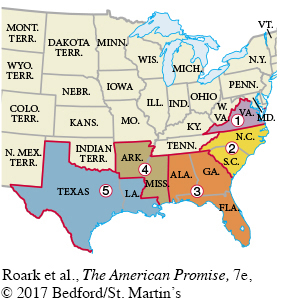The American Promise: Printed Page 451
The American Promise, Value Edition: Printed Page 411
The American Promise: A Concise History: Printed Page 469
Radical Reconstruction and Military Rule

When Johnson continued to urge Southerners to reject the Fourteenth Amendment, every southern state except Tennessee voted it down. “The last one of the sinful ten,” thundered Representative James A. Garfield of Ohio, “has flung back into our teeth the magnanimous offer of a generous nation.” After the South rejected the moderates’ program, the Radicals seized the initiative.
Each act of defiance by southern whites had boosted the standing of the Radicals within the Republican Party. Except for freedmen themselves, no one did more to make freedom the “mighty moral question of the age.” Radicals such as Massachusetts senator Charles Sumner and Pennsylvania representative Thaddeus Stevens united in demanding civil and political equality. Southern states were “like clay in the hands of the potter,” Stevens declared in January 1867, and he called on Congress to begin reconstruction all over again.
In March 1867, Congress overturned the Johnson state governments and initiated military rule of the South. The Military Reconstruction Act (and three subsequent acts) divided the ten unreconstructed Confederate states into five military districts. Congress placed a Union general in charge of each district and instructed him to “suppress insurrection, disorder, and violence” and to begin political reform. After the military had completed voter registration, which would include black men, voters in each state would elect delegates to conventions that would draw up new state constitutions. Each constitution would guarantee black suffrage. When the voters of each state had approved the constitution and the state legislature had ratified the Fourteenth Amendment, the state could submit its work to Congress. If Congress approved, the state’s senators and representatives could be seated, and political reunification would be accomplished.
The American Promise: Printed Page 451
The American Promise, Value Edition: Printed Page 411
The American Promise: A Concise History: Printed Page 469
Page 452Radicals proclaimed the provision for black suffrage “a prodigious triumph,” for it extended far beyond the limited suffrage provisions of the Fourteenth Amendment. When combined with the disfranchisement of thousands of ex-
Despite its bold suffrage provision, the Military Reconstruction Act of 1867 disappointed those who also advocated the confiscation of southern plantations and their redistribution to ex-
Declaring that he would rather sever his right arm than sign such a formula for “anarchy and chaos,” Andrew Johnson vetoed the Military Reconstruction Act, but Congress overrode his veto. With the passage of the Reconstruction Acts of 1867, congressional reconstruction was virtually completed. Congress left whites owning most of the South’s land but, in a departure that justified the term radical reconstruction, had given black men the ballot.